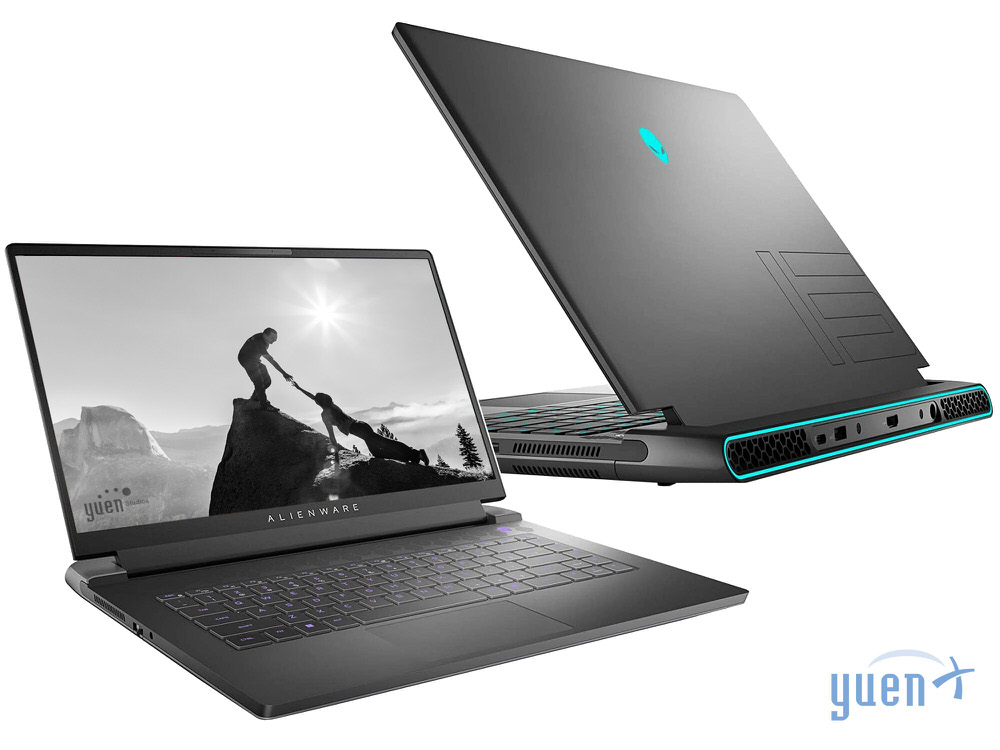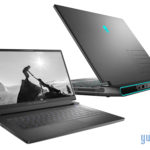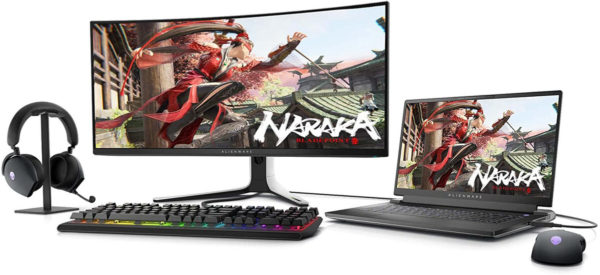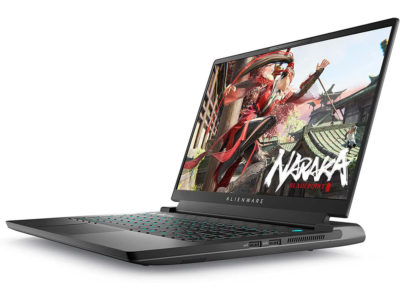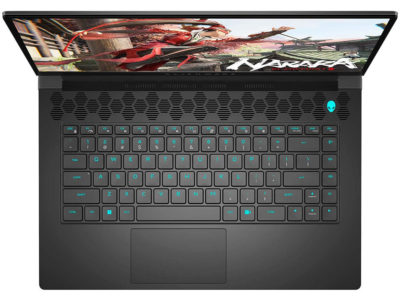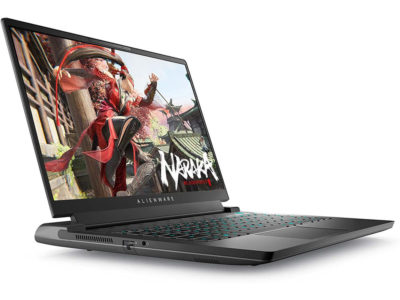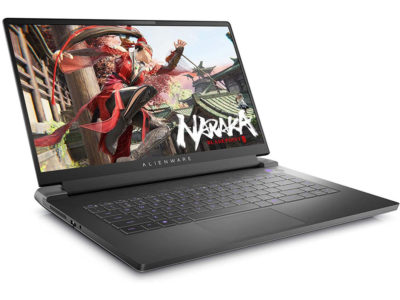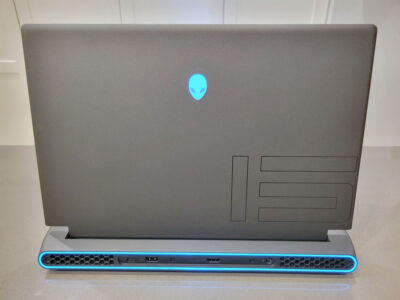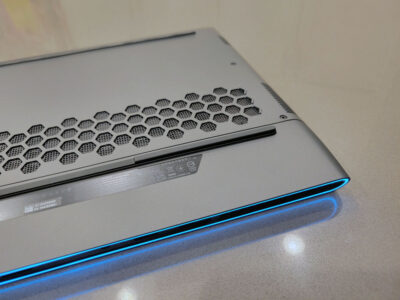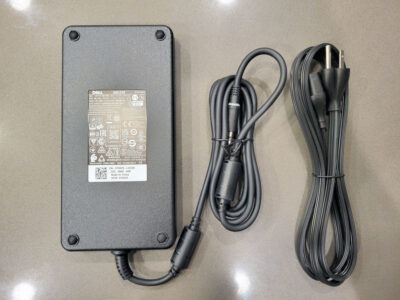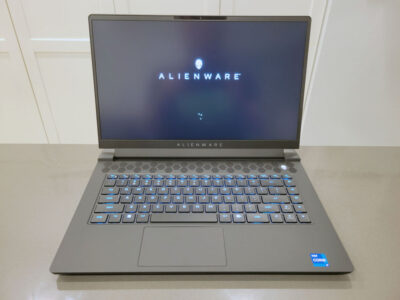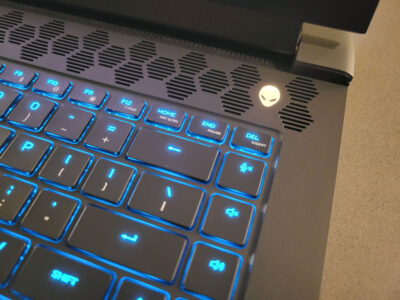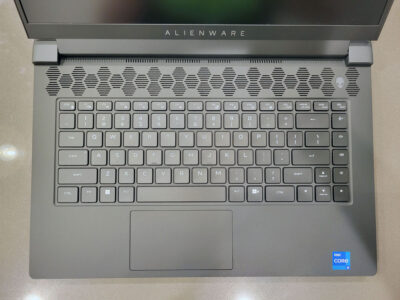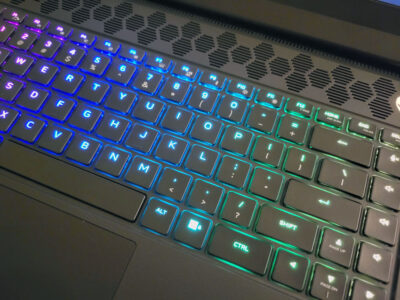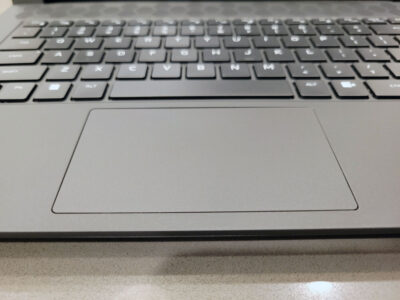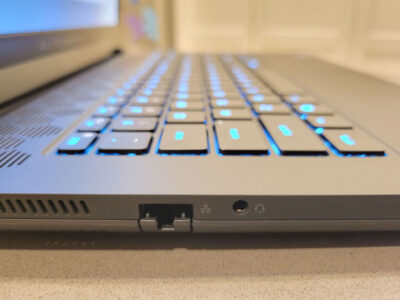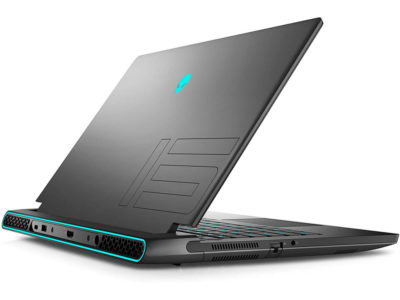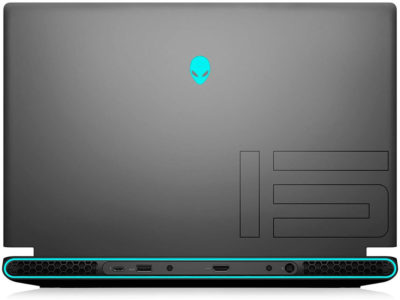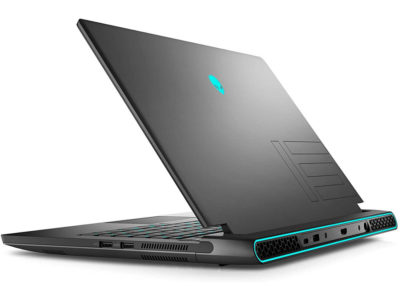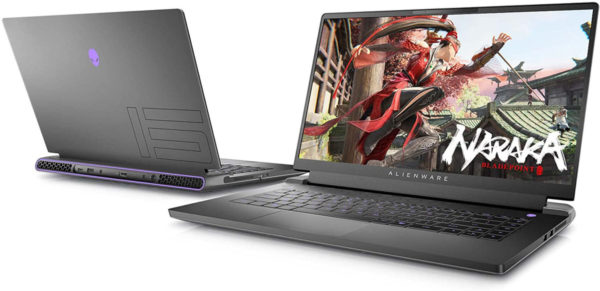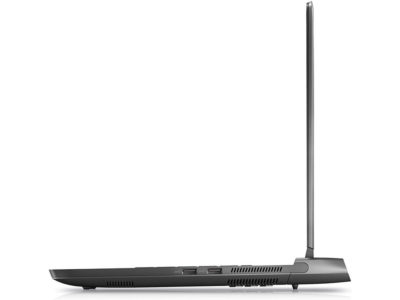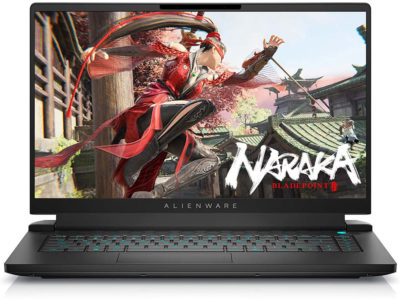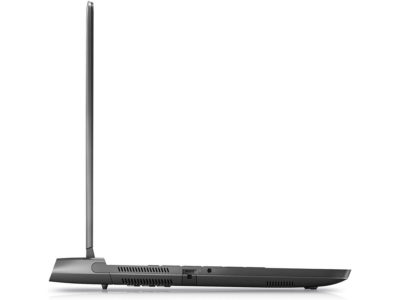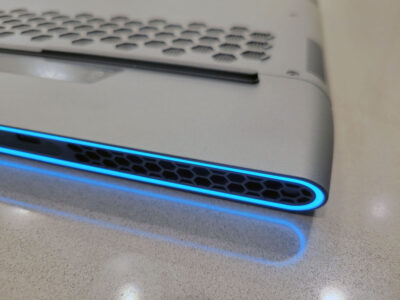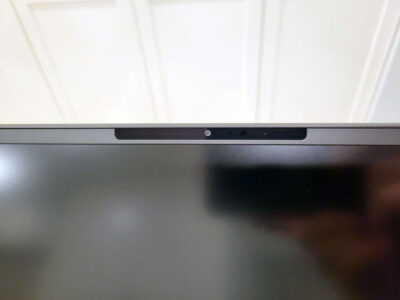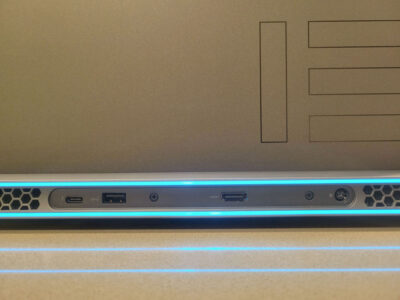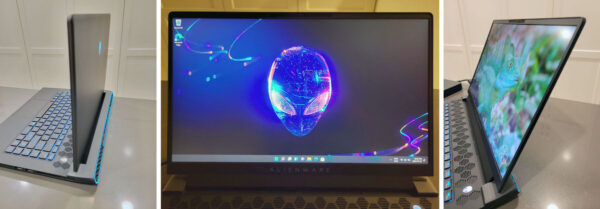Alienware m15 R7 15.6" Gaming Laptop (RTX 3060, Core i7-12700H) AWM15R7-7693BLK-PUS
Contents
Butter Smooth Performance
Computer gaming has come such a long way since when laptop batteries used to only last 30 minutes, weighed a ton, and were unwieldy thick and large to comfortably carry around. Then CPU makers (the brain of the computer), Intel and AMD, came up with a solution: use the integrated graphics for everyday processing (and battery maximization) and automatically switch to the dedicated graphics processor for optimal gaming performance. Alienware has long been synonymous with powerhouse gaming even after Dell bought the company.
In this article, we are going to take a look at the Alienware m15 R7 (2022), and whether the company’s claim of it being their “most powerful 15 [inch] laptop ever” holds any truth against its predecessors and competitors. Spoiler: Yes, it does.
Disclosure: This product was received through Amazon Vine, an Amazon invite-only program offered to its most helpful reviewers for an honest, unbiased, unpaid opinion. Vendors cannot influence the review, neither a positive nor negative evaluation affects membership, and item’s value may be taxable income. YuenX is independent of Vine. Learn more
In A Nutshell
This year’s six-pound Alienware m15 R7 is housed in the exact same form factor as its 2021 R6 predecessor with a virtually indistinguishable exterior. However, underneath the hood are JUST-released (in Q1 2022) central and graphics processing units, packing the latest technology from Intel (Core i7-12700H, 12th gen) and Nvidia (a refreshed GeForce RTX 3060) into a small space with improved (beefier) cooling fans, load-balancing heat pipes, larger vents along the bottom, and fast DDR5 memory. In testing, all this design contributed to games running smoothly under sustained 50W-60W loads for hours without any noticeable sign of thermal throttling that the predecessors were sometimes plagued with. Be sure to always upgrade to the latest firmware and drivers to unlock any and all improvements made by Alienware since the initial release. You may also want to experiment with Intel’s Extreme Tuning Utility (XTU) or Alienware’s AlienFX to see if more performance can be unlocked for the types of tasks you want it to handle. The Core i7-12700H is fully unlocked and overclockable, and keeping the laptop plugged into the wall gives it the ability to run at peak power.
A 1440p (QHD) screen is a perfect compromise between gaming performance and high resolution on a 15.6″ laptop. Having 4K on such a small screen would only make small text more difficult to read, but also make the graphics processor work harder than it should, and result in shorter battery life.
The 15.6″ QHD 1440p, non-touch display panel refreshes at a whopping 240Hz that creates VERY fluid graphics that are essential to gaming. Indeed, these games ran impressively smooth at about 40+ fps @ 4K (with an external monitor), 90fps @ 1440p, and 120fps @ 1080p with every graphics setting maxed out — with quick responses to my Razer mouse movements:
- Cyberpunk 2077 / Total War: Warhammer 3 / God of War (Yes, available for PC!) / Call of Duty: Vanguard
- Assassin’s Creed: Valhalla / Red Dead Redemption 2 / Counter-Strike: Global Offensive (Free)
- Far Cry 6 / World of Warcraft / Grand Theft Auto 5 / Tom Clancy’s Rainbow Six: Extraction
The multi-touch gesture glass touchpad worked wonderfully, and the graphics processor is also ready for Virtual Reality (VR) and Augmented Reality (AR) experiences. I sadly no longer have the tethered Oculus Rift S to test with, but it was replaced by the Oculus (sorry, Meta) Quest 2 VR standalone headset anyway.
Photo editing within Adobe Lightroom and Photoshop gained a considerable edge with the m15 R7 over my four-year-old, CyberPowerPC gaming desktop. Manipulations of large graphics and photos completed seconds faster on the Alienware with Intel’s 20 threads, 14 cores, and maximum turbo frequency of 4.70 GHz, and made me question whether it was time to upgrade the PC. Alas, a laptop can only be upgraded or expanded in so many ways. Speaking of which, both the DDR5 memory and M.2 2280 Class 40 storage are easily user-upgradeable by removing the bottom cover to reveal a pair of slots for each. My unit came with two 8GB DDR5 4800MHz RAM modules for a total of 16GB, and so to get the maximum 64GB, both modules would have to be replaced. I am perfectly fine with 16GB. Storage came in the form of 512GB of PCIe NVMe M.2 2280 and can be expanded to 4TB.
SSD M.2 Numbers: The first two digits correspond to the width of the drive. The last two is the length. Example: 2280 refers to 22mm width, 80mm length.
How did general productivity software, like Microsoft Office or Google Chrome, run? I had opened over 40 browser tabs, multiple Microsoft Outlook email messages, and a slew of other work applications, and did not see any performance degradation with the exception of a constant, whispering fan sound. Some may find any noise annoying, but it did not bother me much due to perhaps having tuned it out as white noise over the years, especially when gaming at a louder volume where I do not notice it at all. The fan spins down completely at idle with a Balanced thermal profile.
Battery life at 86Wh has been slightly extended with Nvidia’s Optimus technology that dynamically switches between Intel’s integrated GPU and Nvidia’s GeForce. What this means is that when you are not gaming, the less resource-intensive Intel GPU is utilized to maximize battery life, and once you fire up a game, the dedicated GeForce GPU takes over to give the graphics boost needed for that activity. The battery lasted about 5 hours straight in a mix of office work and quick, 30-minute gaming during lunch before I had to seek the AC charger. Without gaming, I got as much as 8 hours of web browsing with 20% of battery life still remaining. Not too shabby! For comparison, my Microsoft Surface Pro 8 once lasted 11 hours with 20% battery left. The included power adapter is 240W.
Mind you, the laptop is heavy at 6 lbs (14.02″ W x 0.94″ H x 10.73″ D) when compared to my favorite productivity device, the Surface Pro 8 (2 lbs). But high-end gaming laptops had never really been known to be light or pack impressive battery life. Comparing the build quality of the m15 R7 with the older R4, it has gotten considerably worse over the years with Alienware opting to shave cost and weight by transitioning the chassis from metal to plastic. That also means that both the bottom and top covers all flex. I would have much preferred if the company opted to use magnesium alloy for a more premium look that Microsoft’s Surface products are known for, but of course, that would have made the m15 R7 more expensive to buy. Only one color choice was available: “Dark Side of the Moon”. Funny name of a color. The customizable, rear stadium lighting adds a nice ambiance and unique look to an otherwise boring color scheme, and the glowing Alien logo is stunning.
I despise the keyboard layout with the location of the Home, End, Del, and Page Up/Down keys, but you know what? The Surface Pro keyboard has them at similar locations too and you will get used to it. Nonetheless, the Alienware’s Page Up/Down keys requires you to push the Fn (Function) key to activate. Three keyboard options are offered: single-zone lighting, per-key RGB (customized via AWCC software), or mechanical per-key RGB. Mine was the second one where each key’s color could be customized.
Standard number and types of ports are included: USB-A, USB-C, HDMI, Gigabit Ethernet RJ-45, and headset jack. WiFi 6 is included, but unless you have a WiFi 6 household, its benefits will not make much of a difference for most consumers for at least a few years. Speakers were nothing to brag about at 5W (2.5W x 2) and — despite having Dolby Atmos — lacked clarity and bass, though loud enough to watch a movie in a hotel room.
Windows 11 Home is included, and with that all the security modules that Microsoft’s latest operating system requires, including TPM 2.0 that enables Windows Hello for biometric authentication and BitLocker for data protection. Most gamers I had spoken with over the years do not care about data encryption, thinking they have nothing to hide, but as someone who works in the Cybersecurity field, I assure you, any little piece of data a threat actor gathers about you could be exploited to potentially cause harm to you or someone you know, and/or access precious resources like your personal email, photos, finances, and (ahem) private video collection. Dell unfortunately included some bloatware, although you could easily uninstall them by going to the “Add or remove programs” setting.
Your Data: You may have nothing to hide, but any little piece of data a threat actor gathers about you could be exploited to cause harm to you or someone you know. Windows 11 requires TPM 2.0 to help secure the laptop and its data.
The Alienware m15 R7 is also available with the Intel Core i9-12900H CPU and Nvidia GeForce RTX 3050 or RTX 3070 Ti GPU. My unit’s RTX 3060 sits right in-between in graphics performance, and the RTX 3070 Ti is about 71% faster overall at nearly double the price. These graphics cards also pack enough serious power for mining cryptocurrency.
Better efficiency and more overall performance accents this year’s Alienware m15 edition that, at about $1,800, may be too pricey for some college-aged gamers, but Dell (parent company of Alienware) has indeed got a winning machine on its hand with excellent performance, a high-quality display, and some of the newest components packed into the same form factor as last year’s R6 model. Mind you, the company also offers $4,000 notebooks, but believe me, unless you are a hardcore gamer like I once was, that price premium only made me regret having spent that much many, many years ago for power I hardly ever harnessed as a professional photographer and power user.
What’s Good? What’s Bad?
Pros
- Excellent gaming and graphics processing performance for its size
- Latest games ran very well at their highest settings
- Adobe Lightroom and Photoshop quickly breezed through heavy photo editing tasks
- Butter smooth graphics and tack-sharp screen with high refresh rate
- Ray Tracing comes to life with excellent performance
- Vibrant, 1440p with good viewing angles
- Good battery life thanks to the latest Intel and Nvidia processors
- Automatic switching between Intel’s integrated and Nvidia’s GPUs for optimized battery life or best gaming performance (via Nvidia’s Advanced Optimus)
- Overclockable with Intel or Alienware’s own tools
- Fast DDR5 4800MHz memory and upgradable to 64GB
- Speedy PCIe NVMe M.2 SSD storage upgradeable to 4TB
- Responsive, multi-touch gesture glass touchpad
- Virtual Reality and Augmented Reality ready
- Fun, customizable lighting options
- Responsive, RGB-lit keyboard
- Good number and types of ports
- 3x USB-A 3.2
- 1x USB-C (Display Port 1.4, PD Power Delivery, Thunderbolt 4)
- 1x HDMI 2.1
- 1x RJ-45 Gigabith Ethernet
- 1x Headphone Jack
- Wi-Fi 6E AX1675, if your home is wired to support it
- Hardware security features that Windows 11 takes advantage of
- Support for Windows Hello and BitLocker drive encryption
- Portable, though heavy at 14.02″ W x 0.94″ H x 10.73″ D
Cons
- Heavy at 6 lbs
- Plastic chassis and only one available color choice
- Quite thick in some areas
- Fan noise can get loud under heavy load
- Weak speakers despite Dolby Atmos support
- Alienware-installed bloatware with its Windows 11 image
- Cringeworthy 720p camera with no built-in hardware privacy shutter
- No Fingerprint scanner for quick unlock with Windows Hello
- Keyboard’s extended key layout is not the best, but there’s only so much space available with a 15″ laptop
Alienware m15 R7 Manuals: Hardware / Product Specs
Final Thoughts
Nearly three years ago, I reviewed the above-average, popular budget gaming laptop, the Dell G7 17″ G7790-7662GRY-PUS. Despite debuting at $1,399 — $400 less than this Alienware m15 R7 made by the same parent company — I often wondered why someone would choose a laptop that was considerably less capable for gaming and had terrible battery life just to save a few hundred dollars. But I also saw the draw of an attractively-priced, 17″ portable for those who found 15″ too small.
Nonetheless, for those who want a relatively inexpensive laptop that excels at gaming with the latest Intel and Nvidia processors, has good battery life, a vibrant display with high refresh rates and good viewing angles, and generous memory and storage upgrade capacities, Alienware’s latest 2022 revision of its popular m15 gaming laptop is EASY to recommend.
Where To Buy
- Alienware m15 R7 (2022) Gaming Laptop
- Memory Upgrade (4800MHz)
- Max 32GB module supported (64GB total)
- Crucial, Kingston, Samsung, Micron, or Hynix brand recommended
- SSD Storage Upgrade (PCI NVMe M.2 2280)
- Max 2TB module supported (4TB total)
- Samsung Pro/EVO, Western Digital (Black), Seagate Firecuda, Sabrent Rocket, Kingston Fury, or Crucial MX recommended
- Memory Upgrade (4800MHz)
- CyberPowerPC Gaming Computer
- Microsoft Surface Pro / Go 2
- Meta (Oculus) Quest 2 VR Headset
- PC Games
- Adobe Lightroom Photo Editor
Related Reviews
- Laptops
- Dell G7 G7790-7662GRY-PUS (2019) Gaming
- Acer Aspire 5 (2021)
- HP Chromebook 14 (2021)
- Lenovo IdeaPad 3 (2021)
References
Read on to learn more about what CPUs, WiFi 6 (vs 5), and the disk storage differences are.
What is an Intel Processor?
The CPU (processor), the “brain” of a computer, is an important piece to gauge performance. It is responsible for processing all the general calculations and instructions to carry out everything an electronic device can do. The faster it can “think”, the faster things will get done.
Intel has maintained a significant lead in the computer industry with only AMD having been its noteworthy rival for decades. AMD had actually made a significant comeback with its Ryzen product line to compete against Intel’s flagship “Core”. The numbering scheme for Intel goes like this (from lowest to highest performance): i3, i5, i7, and i9. AMD’s Ryzen series mirrors that. Essentially Intel’s Core i3 is the least expensive and targets consumers wanting a basic computer to do basic things like web browsing, office work, media consumption, and casual gaming with better battery life than the higher models. Core i7 and i9 target hardcore users who want top-notch performance.
What is WiFi 6?
The new WiFi standard is not just about speed. It can more efficiently send data to multiple devices at once (like a delivery driver stopping by multiple clients on the way to the final customer), improve battery life, and security. However, the router and devices must all support the new 802.11ax standard for the benefits to be realized.
WiFi 6 is 100% backwards compatible with WiFi 5 and older devices and as such is more future proof.
Storage and Expansion
Installation/Upgrade: SATA/M.2 SSD/Memory
Replacing or adding a 2.5″ SATA drive, M.2 SSD, or RAM is generally hassle-free. Simply pop off the screws found at the bottom of a computer to reveal the storage/memory slots. Be sure to educate yourself about which parts to buy, as I will explain below.
Drive Differences: SATA, SSD, mSATA, M.2, NVMe
Hard disk drives (HDD) are mechanical devices whose performance was primarily based on the RPM (revolutions per minute) rating. They were generally 5400 or 7200 RPM (and beyond) — the higher the number, the faster it would usually perform. As with anything mechanical, they break down over time as the components age.
Flash-memory based Solid State Drives (SSD) were introduced in the 1990s and were VERY expensive. SSD promised resistance to physical shock, faster performance, lower heat output, and more silent operation. Even to this day, SSDs still cost more than similarly-sized HDDs.
SSD and HDD connect to your computer via multiple interfaces. Relative to most Mini PCs and Laptops, we are only concerned with the SATA and PCIe ones. SATA can connect two drive types:
- 2.5″ SATA SSD (nowadays used in most laptops and desktop PCs and is physically larger)
- mSATA and M.2 SSD (typically used in Mini PCs and laptops), each with their own connection types
Mini-SATA (mSATA) is older and slower than M.2, and the latter can also connect to the newer, significantly faster PCIe interface (those drives are known as NVMe M.2 SSD).
M.2 SSD 2230, 2242, 2260, 2280? What do they mean?
- The first two digits correspond to the width of the drive
- The last two are the length
A M.2 SSD 2280 is 22mm wide and 80mm long. This is important to know, especially with Mini PCs or Laptops where space is scarce. If you purchase a 2280 drive and the computer only has room for 2230, you would not be able to use the former.

